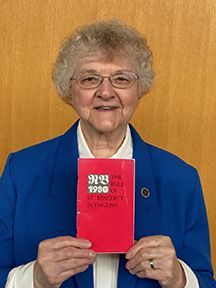Benedictine Values
*Prayer and Eucharist
*Community Life
*Hospitality
*Solitude
*Beauty

Who is Saint Benedict?
Benedict was born in Italy in the sixth century. He lived in times not so different from our own.The Roman Empire was disintegrating. There were extensive wars, destruction and violence. Morality was low and people lived in fear for their safety.
As a student in Rome, Benedict had a religious conversion and fled the city to live as a hermit. Because of his holiness, people pursued him and asked him to teach them how to seek God and how to grow in their own goodness. Benedict did teach them. He also founded monastic communities and wrote a rule which Benedictines still follow today.
The Rule is not so much a set of directives but a way of life, a plan to live radically, the teachings of the Gospel. For Benedict everything points to Christ. He urges his followers to prefer nothing whatever to Christ. This means seeing Christ in others, taking time for prayer and solitude, and treating everything and everyone as sacred. It means being free – free from attachment to power, possessions or prestige. It means to be fully alive and awake to the love of Christ.

The Rule of Saint Benedict
Saint Benedict says that the most important qualification for accepting new community members is that they “seek God.” He discerned, after trying various forms of monastic life himself, that for many people the most successful way of facilitating the search for God is in the context of community (for mutual support and witness), under a Rule (for simplicity, stability and accumulated wisdom) and a community leader (for wise and honest guidance and freedom from unnecessary concerns). He believed that a moderate lifestyle was healthiest to support a life with many hours of prayer, study, holy reading and manual labor; too much or too little food, sleep, access to material goods, or curiosity about worldly happenings would take energy away from God seeking.
Each day of a monastic’s life includes regular times for communal prayer – the “Liturgy of the Hours,” times for personal prayer and holy reading of the Scriptures, periods of manual labor and craftsmanship, and common meals with mutual service of waiting table and cleaning up. Following this daily pathway keeps monastics on the track of searching for God without side roads into distracting activities.
Benedict disposed of a social problem of his day (social class distinctions from nobility down to slaves) by assigning community rank by the day and hour the candidate appeared on the doorstep. Modern society may have different distinctions of wealth or education, but this automatic equalizing practice still continues. Mutual respect, love, service, patience, obedience and sharing of wisdom in communal discernment bind the community in searching for God and assisting one another in doing so. Even today, not all religious Orders call upon every member to participate in community decision making.
While Benedict set apart certain places and times when the monastics were to be apart from guests and pilgrims for the silence and solitude necessary for reflection, he was sensitive to the neighbors’ needs. The members used their gifts of healing – spiritual and medical – to assist the sick who came to the door; they fed the hungry and gave shelter to travelers and pilgrims going to holy places; they evangelized the still mostly “pagan” people in villages surrounding the monastery. Benedictines throughout history, and still today, offer their services to the local church according to the needs of the people and the ability of the monastic members to meet those needs; thus Benedictines serve in varieties of ministries.
~ +Sister Edith Selzler, OSB
